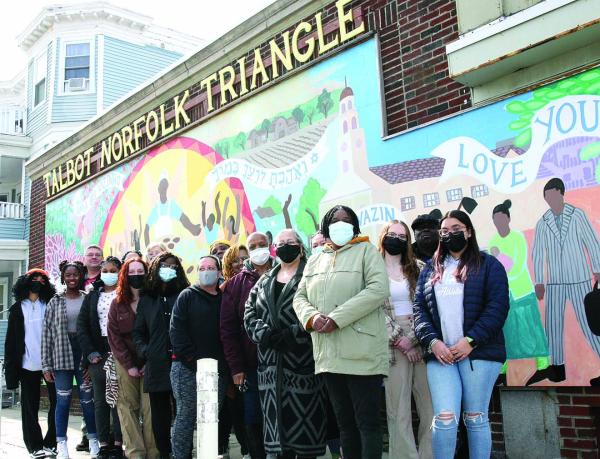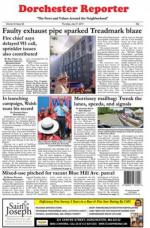March 9, 2022

Above, a group of multi-generational neighbors from Talbot Norfolk Triangle in Dorchester and Boston Project Ministries gathered for a photo last weekend in front of the mural that was painted a few years ago by Mun Hart, a young neighborhood resident. At right, Codman Academy kindergarten teacher Tasha Harris in front of the nearly completed Healing Micro-Forest on Norfolk Street that will soon be a welcome addition to the increasingly green corridor along Norfolk Street. Seth Daniel photos
Over the past decade, multiple illegal dumping sites in the Talbot Norfolk Triangle (TNT) neighborhood, have been transformed into relaxing spaces for reflection, concerts, and forest bathing, with a fruit orchard also in the works, all thanks to a multi-generational people-powered movement among neighbors.
Residents in the district teamed up with Boston Project Ministries as far back as 2009 to envision a relaxing green space corridor, starting at Codman Square and ending at the train tracks near Woodrow Avenue. Today, much of that vision has come to pass, with several new achievements about to be added.
A series of parks and community gardens joined several colorful murals in the last few years, and plans for an orchard and a community art/concert space are in the works. Additionally, a “healing forest” will open along the corridor this spring.
And there’s this: The massive Codman Burying Ground on Norfolk Street, operating under the auspices of the Second Church, received $350,000 last week from the city’s Community Preservation Committee for the rehabilitation of the historic cemetery and the building of a community park.
All of which adds up to a major turnaround for a stretch of urban space that was threatened with gang violence, illegal dumping, and a breakdown in the sense of community.
“The playground and community garden and the open spaces we’ve done have really become the ties that bind us together,” said resident Gail Granville. “We’ve had great inter-generational experiences…The beautification is just a big plus. I think it has contributed to the crime going down here. This area was at one point like the wild, wild West. These improvements and the improvements to the vacant lots and such have made people feel they belong and are connected.”
Added Elmhurst Street neighbor Paul Malkemes, of both TNT and Boston Project Ministries: “It’s a really different experience on Norfolk Street now, and we believe that in the future it will be an even better experience…The feel and the face of Norfolk Street since 1995 is drastically different. The murals have made a difference, but I think the garden and green spaces are really transformational.”
Malkemes said that after many years of activism, a children’s park on Elmhurst Street was finally completed in 2009.That sparked major momentum: It led to a neighborhood walk where a group of 30 or more residents analyzed each vacant lot and their use preferences. Everything was suggested, from new development to business opportunities, but what stuck out was the desire for a green space master plan.
“People had the idea that it would be nice if there were many sites that were open space along Norfolk Street that were linked together as a system,” said Malkemes. “They didn’t want them to be a replication of one another but different expressions of green space.”
That led to a park being constructed by neighbors and local youth over two summers at a once-vacant lot on the corner of Norfolk and Darlington streets. A few years later, the idea of a community garden at 106 Norfolk took hold. By 2013, that was up and running.
The TNT group is working at setting up centerpiece space at the corner of Norfolk and Woodrow, where they could present concerts and public art installations that change with the seasons. Beyond that, they have dreams for a fruit orchard on Woodrow Avenue.
“That would be just another different expression of open space,” Malkemes said. “Maybe our kids don’t always get to see orchards out of Boston in other parts of the state, but this would allow them to see a small part of that here.”
A key element of the area’s revival has been the buy-in from youth in the neighborhood like Mun Hart. Now 20 years old, Hart said she has been working on TNT projects and ideas since she was 12.
“I feel like it’s really good to give young people a part and give them a voice because this is the community they’ve grown up in and probably will live in the rest of their lives,” she said. “Having a hand in helping build these things, and having adults actually listening to you and inviting your opinion into the process is empowering at a young age.
She added, “There’s always something we have done together in the neighborhood, and you can see it and say, ‘I did that.’”
Engaging with partners to help develop the green corridor was another tenet of the plan. Recently, Codman Academy became TNT’s first partner in developing a “healing” micro-forest near the Codman Square Neighborhood Health Center. The triangular piece of land will open later this spring as the neighborhood’s first official healing forest, an effort to initiate the Japanese concept of “Shirin-yoku,” or forest bathing: going to the forest to connect with nature specifically for improving health and wellness.
Codman Academy kindergarten teacher Tasha Harris, who lives in the area, said she looks forward to bringing students to the space, and for the health center to use it as a healing space and for the community to add the micro-forest to its library of green space achievements.
“We wanted a healing micro-forest in the area…where we can regroup and take a moment to rest,” she said. “It was the best of both worlds for me as a teacher here and a resident and it brought up questions because we are the most diverse neighborhood in Boston. Why aren’t these spaces here? As a homeowner, I wondered why I had to go to JP for something like this?”
So it was that Codman Academy and Harris designed and construct the new space, with the finishing touches coming later this spring.
With the smell of pine needles invigorating the senses, and promoting better health, it was again a different way for open space to be used, Malkemes said.
“It was very fitting when Codman Academy came and wanted to do that project because it fit into the vision that it didn’t have to be just our group,” he said.
Granville said she has been encouraged over the last few years as the improvements have taken hold. “What we’ve done connects everyone because it’s inclusive and you see all walks of life and all races; it just brings us all together,” she said.
And for those who frequently ask her whether she’s going to “cash out” and leave the neighborhood, the answer is an emphatic ‘no.’
“Everyone has always said to me, ‘Why do you live there?’” she said. “They tell me it’s not safe…People tell me the [housing] market is hot – leave now while you can. I tell them I’m not leaving my community. I love it here.”



